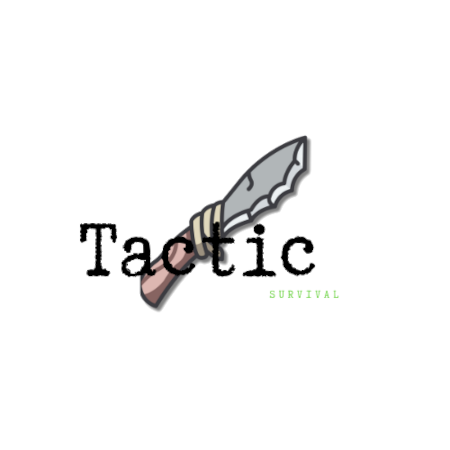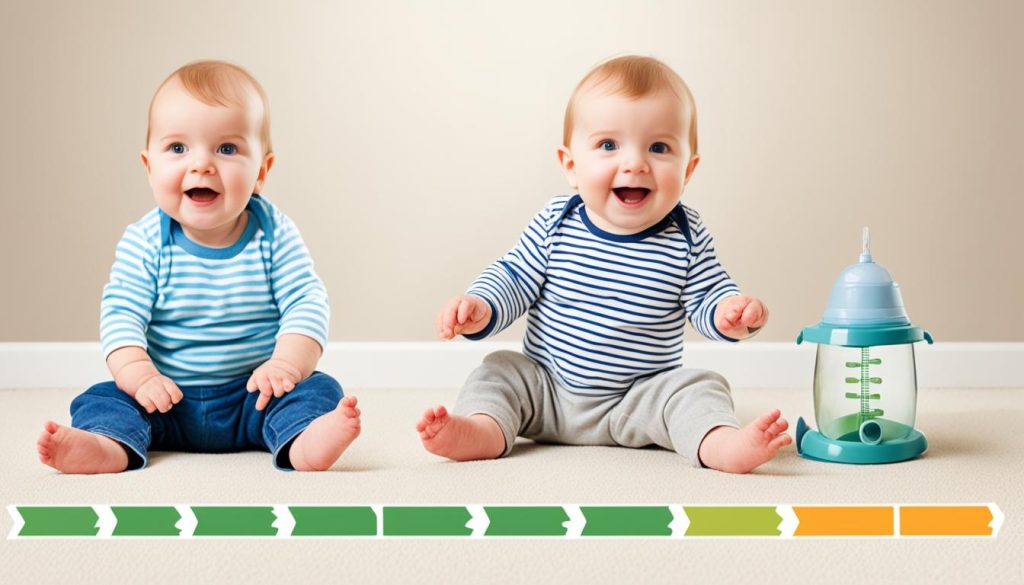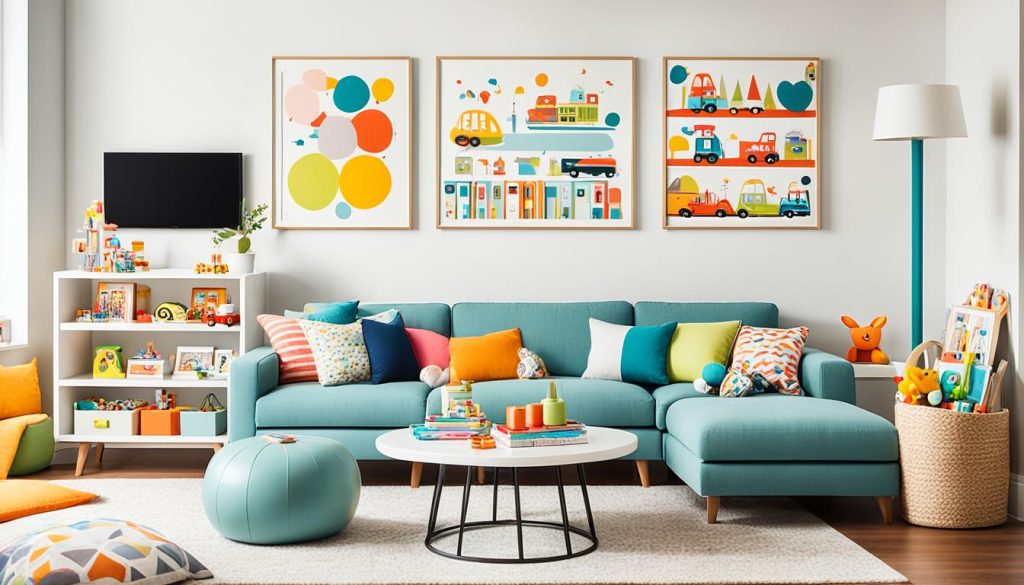Millions of kids are hurt each year at home. They face risks like falls, burns, and drownings. This danger could end up in a terrible accident for your child.
Making your home safe is key. With the right steps, accidents can go down. Your kids will have a safer place to run around and learn.
Key Takeaways:
- Childproofing your home is crucial for the safety and security of your children.
- By following recommended safety practices and using child safety devices, you can greatly reduce the risk of injuries.
- No device is completely childproof, but implementing these measures can help create a kid-friendly environment.
- Regularly reassess and maintain your childproofing measures as your child grows and develops new skills.
- Creating a safe and kid-friendly home is a continuous process that requires vigilance and awareness.
Recommended Child Safety Devices and Practices
It’s vital to set up the right safety devices and habits for your kids. Proactive steps and using safety products for kids cut the chances of injuries.
Infant Sleep Products
Choose sleep products that follow safety rules for your baby. Go for cribs, bassinets, and mattresses that are up to date on safety to keep your baby safe while sleeping.
Window Safety Measures
Window coverings without cords are a must to avoid getting tangled. Also, use window guards and nets to stop falls and give more protection to your child.
Furniture Anchoring
To stop heavy furniture from tipping, anchor them to the wall. This action can stop accidents involving furniture from happening.
Cabinet and Drawer Safety
Use safety locks on cabinets and drawers to hide dangerous stuff from kids. These locks keep your child from reaching harmful items.
Bathing Supervision
Always watch your child closely during baths to stop accidents and drowning. Be by your child’s side and don’t leave them alone in the tub.
Pool and Spa Safety
Add safety layers to pools and spas like fences and covers. This helps protect your child from water dangers. Always watch over them and teach water safety.
Stair Safety
Keep your child from falling down stairs by using safety gates. Put gates at the top and bottom of stairs to keep your child safe.
Doors and Knobs
Lock dangerous rooms with door knob covers and locks. These add more protection, keeping your child away from risky places.
Fire and Carbon Monoxide Safety
Smoke and carbon monoxide alarms are essential for early warnings. Make sure to install them and check they’re working well often.
Corners, Edges, Outlets, and Plates
Put corner and edge bumpers to guard against sharp corners at home. Use outlet covers to keep children away from electrical sockets. This helps lessen the risk of certain accidents.
Using these safety devices and habits can lower the chances of your child getting hurt. Always remember, safety devices are not 100% secure. Combine them with watchful care and a safe environment for the best safety results for your child.
When to Babyproof Your Home
You need to start babyproofing before your baby can move around by themselves. It’s best to start when you’re pregnant or just after your baby is born. Add more safety measures as your child grows and starts moving. Knowing what to watch out for can make your home safer for your baby.
Babyproofing Timeline
Creating a babyproofing schedule is key to keeping your baby safe. Here’s a simple timeline to follow:
- Prenatal: Think about home safety while you’re pregnant. Start getting items like baby gates and outlet covers.
- Newborn to 3 months: Focus on a safe sleep space and securing items like cabinets and TVs.
- 4 to 6 months: Install baby gates, locks, and safety covers as your baby starts to move more.
- 6 to 9 months: Make sure furniture is stable and protect sharp corners and windows.
- 9 to 12 months: Add more safety measures like locking up cleaners and covering door knobs.
Every baby is unique. Adapt your babyproofing as your baby grows and learns new skills.
Keeping Up with Babyproofing Stages
Babyproofing needs to evolve as your baby gets older. Stay alert for new safety risks and update your babyproofing plan. Look out for these important babyproofing stages:
- Crawling and pulling up: Babies are curious and can reach low dangers. Anchor furniture and keep small objects away.
- Walking and running: Falling becomes a bigger risk. Use safety gates and keep areas free of trip hazards. Make sure furniture won’t topple over.
- Exploring and climbing: Toddlers like to climb and explore. Secure tall furniture, bookshelves, and windows to prevent accidents.
Being proactive and checking for dangers regularly will help keep your child safe as they grow.
Babyproofing Room by Room
When babyproofing your home, deal with risks in every room. Make each room safe for kids to explore. This helps create a safe space for learning and growing.
Kitchen
Start with the kitchen for safety. Use cabinet locks for sharp objects and chemicals. Put stove-knob covers to avoid burns. These steps will protect your child in the kitchen.
Living Room
In the living room, kids play and learn. Use corner guards to soften sharp edges. Put childproof covers on outlets to avoid electrical shocks. Fasten big furniture to the walls. These actions make the living room safer for your little one.
Nursery
Ensure the nursery is a safe sleeping spot. Keep the crib simple, without soft items. Fasten furniture to avoid tip-overs. Place small items and cords out of reach. These steps make the nursery a safe haven for your child.
Bathroom
Bathrooms can be risky for kids. Lock cabinets with supplies and medicine. Use non-slip mats in the tub and watch kids closely when they bathe. Secure the toilet to stop accidents. These actions keep the bathroom safe for your child.
Laundry Room
Laundry rooms are full of potential hazards. Keep detergent pods away to avoid poisoning. Lock up medicines to protect curious children. By doing this, you make the laundry area safer.
It’s important to babyproof every room. Using a checklist and these tips, you can ensure a safe place for your child. This way, your whole house is a secure and loving space.
Furniture and Home Renovations for Childproofing
Keeping your child safe at home is more than just locking cabinets. It means choosing the right furniture and making your home safer in ways you might not think about. By focusing on childproofing in your furniture and design, you cut down on the chance of your child getting hurt.
It’s key to pick furniture that is sturdy and can’t easily fall over. Over 45% of injuries to kids are from falling, so this is really important. Choose pieces with soft edges to lower the injury risk. Also, look for items that have passed strict safety checks for extra peace of mind.
The American Academy of Pediatrics says that furniture and TVs falling over is a big problem now. It’s really important to secure big pieces like dressers and shelves to the wall.
Stay away from furniture with glass tops because they can easily break. Also, don’t cover the floors under high-chairs with rugs to keep your child from slipping.
Outlets and cords can be dangerous too. Make sure all outlets are covered and cords are out of reach. This simple step can help avoid electric shock accidents.
If you have big pieces of furniture, like dressers, consider using anti-tip kits. They help you fasten furniture to the wall to stop it from falling over. This can prevent serious harm to your child.
When updating your home, think about your child’s safety. Add safety gates to staircases to keep your child from falling. If you have a pool, put up a fence that is at least 4 feet high. Kids getting into water alone can be very dangerous.
Childproof Design Tips:
- Choose furniture with rounded corners and higher safety standards.
- Avoid glass top tables and rugs under high-chair areas.
- Secure electrical outlets and cords.
- Consider using anti-tip kits for heavy furniture.
- Install safety gates for staircases.
- Ensure a water safety barrier around pools and spas.
- Never leave children unattended in baths, pools, or spas.
By thinking about your child’s safety while choosing furniture and renovating, you make your home a safer place. Your child’s safety is priority. Childproofing your home is a key part of keeping them safe.
| Child-Related Injury Statistics | Home Safety Measures |
|---|---|
| 80% of child-related injuries occur in the home | Install smoke alarms on every level of the home, inside each bedroom, and outside sleeping areas |
| 45% of child-related injuries are due to falls | Use stable and anchored furniture, avoid glass top tables, and secure rugs |
| – | Install carbon monoxide alarms near sleeping areas |
| – | Ensure a water safety barrier around pools and spas |
| – | Never leave children unattended in baths, pools, or spas |
Conclusion
Childproofing your home is key to keeping your kids safe. Follow safety advice, use tools like safety gates, and make changes in each room to lower risks. This helps prevent kids from getting hurt.
Always check your child’s space as they grow. What’s safe for a baby might not be safe later on. Keep an eye out and update safety steps as needed.
Keeping a safe, kid-friendly home is an ongoing job. Be on the lookout for new safety tips. This way, you’ll always be ready to protect your children at home.


